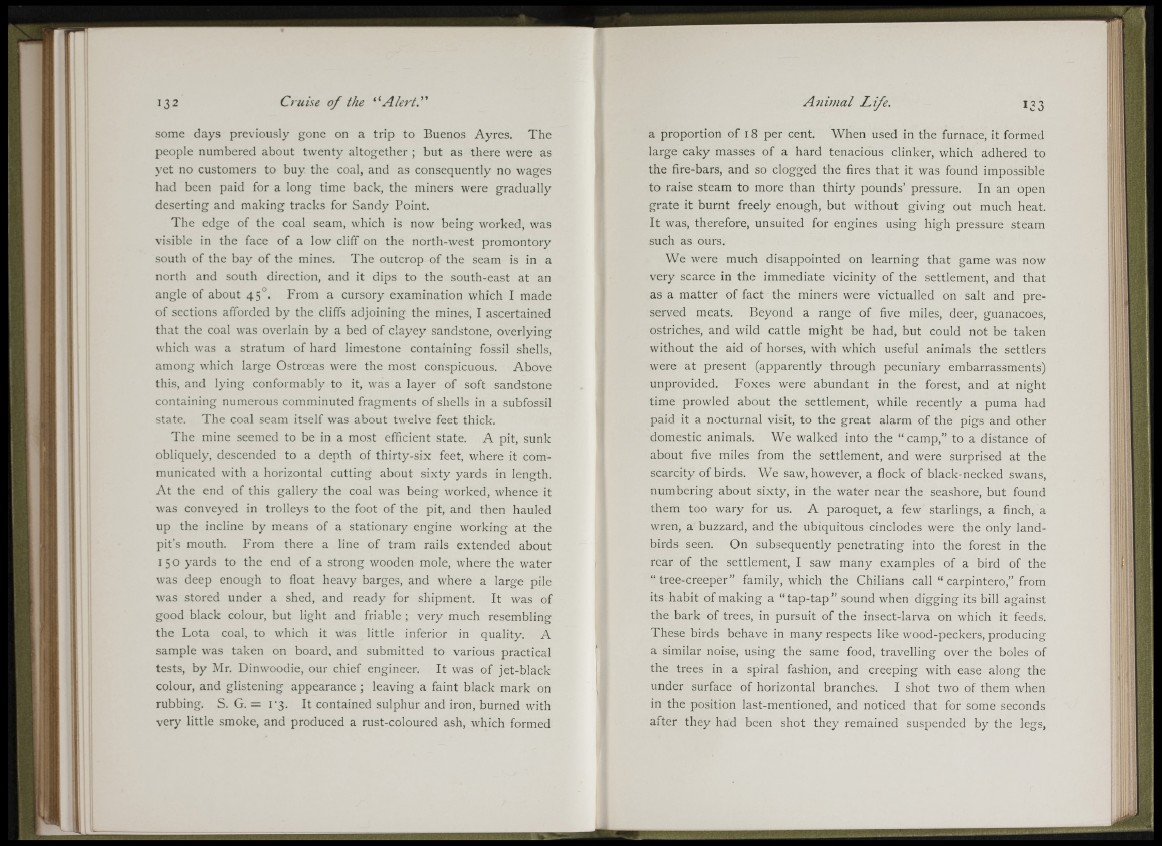
some days previously gone on a trip to Buenos Ayres. The
people numbered about twenty altogether ; but as there were as
}’et no customers to buy the coal, and as consequently no wages
had been paid for a long time back, the miners were gradually
deserting and making tracks for Sandy Point.
The edge of the coal seam, which is now being worked, was
visible in the face of a low cliff on the north-west promontory
south of the bay of the mines. The outcrop of the seam is in a
north and south direction, and it dips to the south-east at an
angle of about 45°. From a cursory examination which I made
of sections afforded by the cliffs adjoining the mines, I ascertained
that the coal was overlain by a bed of clayey sandstone, overlying
which was a stratum of hard limestone containing fossil shells,
among which large Ostroeas were the most conspicuous. Above
this, and lying conformably to it, was a layer of soft sandstone
containing numerous comminuted fragments of shells in a subfossil
state. The coal seam itself was about twelve feet thick.
The mine seemed to be in a most efficient state. A pit, sunk
obliquely, descended to a depth of thirty-six feet, where it communicated
with a horizontal cutting about sixty yards in length.
At the end of this gallery the coal was being worked, whence it
was conveyed in trolleys to the foot of the pit, and then hauled
up the incline by means of a stationary engine working at the
pit’s mouth. From there a line of tram rails extended about
150 yards to the end of a strong wooden mole, where the water
was deep enough to float heavy barges, and where a large pile
was stored under a shed, and ready for shipment. It was of
good black colour, but light and friable ; very much resembling
the Fota coal, to which it was little inferior in quality. A
sample was taken on board, and submitted to various practical
tests, by Mr. Dinwoodie, our chief engineer. It was of jet-black
colour, and glistening appearance ; leaving a faint black mark on
rubbing. S. G. = 1-3. It contained sulphur and iron, burned with
very little smoke, and produced a rust-coloured ash, which formed
a proportion of 18 per cent. When used in the furnace, it formed
large caky masses of a hard tenacious clinker, which adhered to
the fire-bars, and so clogged the fires that it was found impossible
to raise steam to more than thirty pounds’ pressure. In an open
grate it burnt freely enough, but without giving out much heat.
It was, therefore, unsuited for engines using high pressure steam
such as ours.
We were much disappointed on learning that game was now
very scarce in the immediate vicinity of the settlement, and that
as a matter of fact the miners were victualled on salt and preserved
meats. Beyond a range of five miles, deer, guanacoes,
ostriches, and wild cattle might be had, but could not be taken
without the aid of horses, with which useful animals the settlers
were at present (apparently through pecuniary embarrassments)
unprovided. Foxes were abundant in the forest, and at night
time prowled about the settlement, while recently a puma had
paid it a nocturnal visit, to the great alarm of the pigs and other
domestic animals. We walked into the “ camp,” to a distance of
about five miles from the settlement, and were surprised at the
scarcity of birds. We saw, however, a flock of black-necked swans,
numbering about sixty, in the water near the seashore, but found
them too wary for us. A paroquet, a few starlings, a finch, a
wren, a buzzard, and the ubiquitous cinclodes were the only land-
birds seen. On subsequently penetrating into the forest in the
rear of the settlement, I saw many examples of a bird of the
“ tree-creeper” family, which the Chilians call “ carpintero,” from
its habit of making a “ tap-tap” sound when digging its bill against
the bark of trees, in pursuit of the insect-larva on which it feeds.
These birds behave in many respects like wood-peckers, producing
a similar noise, using the same food, travelling over the boles of
the trees in a spiral fashion, and creeping with ease along the
under surface of horizontal branches. I shot two of them when
in the position last-mentioned, and noticed that for some seconds
after they had been shot they remained suspended by the legs,
III
t e
li